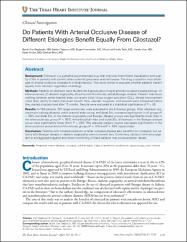| dc.contributor.author | Depboylu, Burak Can | |
| dc.contributor.author | Yazman, Serkan | |
| dc.contributor.author | Harmandar, Buğra | |
| dc.contributor.author | Tetik, Mürüvvet Funda | |
| dc.contributor.author | İştar, Hande | |
| dc.contributor.author | Arslan, Kadir | |
| dc.date.accessioned | 2023-02-14T07:21:43Z | |
| dc.date.available | 2023-02-14T07:21:43Z | |
| dc.date.issued | 2023 | en_US |
| dc.identifier.citation | Can Depboylu B, Yazman S, Harmandar B, Funda Tetik M, Istar H, Arslan K, Ilhan G. Do patients with arterial occlusive dis-
ease of different etiologies benefit equally from cilostazol? Tex Heart Inst J. 2023;50(1):e217747. doi:10.14503/THIJ-21-7747 | en_US |
| dc.identifier.uri | https://doi.org/10.14503/THIJ-21-7747 | |
| dc.identifier.uri | https://hdl.handle.net/20.500.12809/10529 | |
| dc.description.abstract | Background: Cilostazol is a guideline-recommended drug that improves intermittent claudication and quality of life in patients with chronic atherosclerotic peripheral arterial disease. The drug is used for most etiologies of arterial occlusive diseases in clinical practice. This study aimed to evaluate whether patients benefit equally from cilostazol regardless of etiology.
Methods: Patients on cilostazol were divided into 4 groups according to arterial occlusive disease etiology: (1) atherosclerosis, (2) diabetic angiopathy, (3) embolism/thrombosis, and (4) Buerger disease. Patients' maximum walking distance, ankle-brachial index score and distal tissue oxygen saturation (Sto2), clinical improvement onset time, ability to reach maximum benefit time, vascular surgeries, and wounds were compared before they started cilostazol and after 12 months. Results were evaluated at a statistical significance of P < .05.
Results: In 194 patients, 307 target extremities were evaluated in the 4 disease groups. After cilostazol use, maximum walking distance, ankle-brachial index score, and distal Sto2 increased significantly in all groups (P < .001), but distal Sto2 in the diabetic angiopathy and Buerger disease groups was significantly lower than in the atherosclerosis group (P < .001). Ankle-brachial index and distal Sto2 differences in the Buerger disease group were significantly lower (both P < .001). The vascular surgery counts decreased significantly in the atherosclerosis and embolism/thrombosis groups (P = .019 and P = .004, respectively).
Conclusion: Patients with nonatherosclerotic arterial occlusive disease also benefit from cilostazol, but patients with Buerger disease or diabetic angiopathy seem to benefit less. Combining cilostazol with anticoagulant or antiaggregant agents and closer monitoring of these patients may produce better results. | en_US |
| dc.item-language.iso | eng | en_US |
| dc.publisher | The Texas Heart Institute | en_US |
| dc.relation.isversionof | 10.14503/THIJ-21-7747 | en_US |
| dc.item-rights | info:eu-repo/semantics/openAccess | en_US |
| dc.subject | Peripheral arterial disease | en_US |
| dc.subject | cilostazot | en_US |
| dc.subject | Ankle brachial index | en_US |
| dc.subject | Intermittent claudication | en_US |
| dc.subject | Spectroscopy | en_US |
| dc.subject | Near-infrared | en_US |
| dc.title | Do Patients With Arterial Occlusive Disease of Different Etiologies Benefit Equally From Cilostazol? | en_US |
| dc.item-type | article | en_US |
| dc.contributor.department | MÜ, Tıp Fakültesi, Cerrahi Tıp Bilimleri Bölümü | en_US |
| dc.contributor.authorID | 0000-0002-2170-6470 | en_US |
| dc.contributor.institutionauthor | Depboylu, Burak Can | |
| dc.contributor.institutionauthor | Yazman, Serkan | |
| dc.contributor.institutionauthor | Harmandar, Buğra | |
| dc.contributor.institutionauthor | İştar, Hande | |
| dc.contributor.institutionauthor | Tetik, Mürüvvet Funda | |
| dc.contributor.institutionauthor | Arslan, Kadir | |
| dc.contributor.institutionauthor | Gokhan, İlhan | |
| dc.identifier.volume | 50 | en_US |
| dc.identifier.issue | 1 | en_US |
| dc.relation.journal | The Texas Heart Institute Journal | en_US |
| dc.relation.publicationcategory | Makale - Uluslararası Hakemli Dergi - Kurum Öğretim Elemanı | en_US |


















